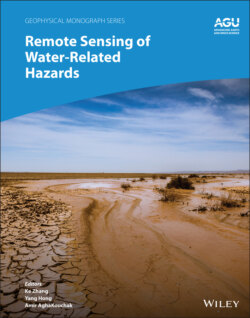Читать книгу Remote Sensing of Water-Related Hazards - Группа авторов - Страница 27
Satellite and reanalysis precipitation products
ОглавлениеThere are seven satellite precipitation data sets and three reanalysis data sets evaluated, as shown in Table 2.1. The reanalysis products are involved because they are important sources of global precipitation data, and comparison with reanalysis products can deepen our understanding of satellite products.
IMERG V06, as the latest release version, has undergone major improvements compared with previous versions. First, IMERG V06 uses total precipitable water vapor to replace geostationary infrared data to calculate the morphing vectors of precipitation systems. Second, IMERG V06 includes data from more sensors such as the TRMM microwave imager (TMI) and the Megha‐Tropiques SAPHIR. Third, passive microwave estimates are morphed at high latitudes to diminish spatial gaps. Please refer to official documents for a more detailed description. IMERG generates three products, i.e., the near‐real‐time Early and Late runs and the post‐real‐time Final run.
Figure 2.2 Topographical map and locations of flash flood events from 2011 to 2018 in Yunnan province,
Source: Based on Tang et al. (2020), Figure 01B, p 03 / Elsevier. based on Ma et al. (2020), Figure 01, p 04 / MDPI / CC BY 4.0.
Table 2.1 Summary of satellite and reanalysis precipitation data sets used in this study.
| Data set | Full name of the data set | Resolution | Period | Reference |
|---|---|---|---|---|
| Satellite Precipitation Data Set | ||||
| IMERG | Integrated Multi‐satellitE Retrievals for GPM Fina run V06B | 0.1°/0.5 h | 2006–present | Huffman et al., (2019) |
| T3B42 | TRMM Multi‐satellite Precipitation Analysis (TMPA) 3B42 V7 | 0.25°/3 h | 1998–present | Huffman et al. (2007) |
| CMORPH | Climate Prediction Center (CPC) MORPHing technique bias corrected (CRT) | 0.25°/3 h | 1998–present | Joyce et al. (2004) |
| PCDR | PERSIANNClimate Data Record | 0.25°/1 d | 1983–present | Ashouri et al. (2015) |
| GSMaP | Gauge‐adjusted Global Satellite Mapping of Precipitation V6/V7 | 0.1°/1 h | 2000–present | Mega et al. (2014) |
| CHIRPS | Climate Hazards group Infrared Precipitation with Stations | 0.05°/1 d | 1981–present | Funk et al. (2015) |
| SM2RAIN | SM2RAIN based on ESA Climate Change Initiative (CCI) | 0.25°/1 d | 1998–2015 | Ciabatta et al. (2015) |
| Reanalysis Precipitation Data Set | ||||
| ERA5 | Fifth generation of ECMWF atmospheric reanalyses of the global climate | ~0.25°/1 h | 1979–present | Hersbach et al. (2020) |
| ERA‐Interim | ECMWF ReAnalysis Interim | ∼0.75°/3 h | 1979–present | Dee et al. (2011) |
| MERRA2 | The Modern‐Era Retrospective Analysis for Research and Applications, Version 2 | ~0.5°×0.625°/1 h | 1980–present | Gelaro et al. (2017) |
TMPA 3B42 V7 (T3B42) is the precursor of IMERG. Both IMERG Final run and T3B42 are corrected using the station‐based Global Precipitation Climatology Center (GPCC). CMORPH and GSMaP are corrected using CPC daily analysis. The PERSIANN Climate Data Record (PCDR) is obtained by adjusting the PERSIANN estimate using GPCC monthly precipitation. CHIRPS (Climate Hazards group Infrared Precipitation with Stations) uses five public metering data streams and several private files detailed in Funk et al. (2015). SM2RAIN is produced using satellite soil moisture data.
The three reanalysis products involved are ERA‐Interim, ERA5, and MERRA‐2. Among them, ERA5 is the fifth generation of global reanalysis conducted by the European Center for Medium‐Range Weather Forecast (ECMWF).
All satellites and reanalysis products are resampled to 0.25° resolution and accumulated to a daily scale to facilitate the evaluation based on CGDPA.
